What are Low-hanging Fruit keywords?
“Low-hanging fruit keywords” are keywords that can be ranked relatively easily compared to other queries within the same keyword cluster.
For a keyword to qualify as low-hanging fruit, it should already be ranking for the website or should have the intent to be ranked for that website or webpage. Not all non-targeted keywords within a cluster are low-hanging fruit!
First, Let me clarify some misconceptions about Low-hanging Fruit Keywords
1. Low-Hanging Fruit Keywords Are Low Competition But Have Sufficient Volume
Many SEOs associate low-hanging keywords with low competition. However, contrary to popular belief, low-hanging keywords can sometimes have high competition.
For instance, the keyword “car insurance” has over 823K searches per month and a keyword difficulty of 100% in the U.S. (according to Semrush). In the same keyword cluster, the keyword “Allstate car insurance” has around 33K searches with the same keyword difficulty of 100%. This keyword can still be considered low-hanging if you have achieved a certain SOV (Share of Voice) within the keyword cluster.
2. Any Low-Hanging Fruit Keyword Can Be Targeted by Any Website in That Niche
Low-hanging fruit keywords are often unique to specific websites or just a few in that niche. Thus, the privilege of calling a keyword “low-hanging” may apply only to a select few.
Using the car insurance example, a market leader in this space can treat any related keyword as low-hanging due to their existing ranking advantage. Meanwhile, for a newer brand, any keywords in this cluster might still pose a significant challenge.
3. Low-hanging fruit Keywords Should Have Enough Volume
Some SEOs look for keywords with decent search volume and low keyword difficulty, but this can be a misguided approach. Even keywords with zero or low search volume can be low-hanging fruit if they meet certain conditions:
- Verify the impression threshold in the Google Search Console – Review impressions over time and evaluate based on current ranking position. This helps filter out stray keywords.
- Examine Google Trends Data for Search Potential – Keyword tools may lag in attributing volume, so trends data can provide insight into emerging interest.
Example: AI Image Generator keyword. As shown below, the impressions were always higher than the Volume. It can take keyword tools 2 to 6 months to correctly index the search volume – long enough for websites to take advantage of the “search potential.”
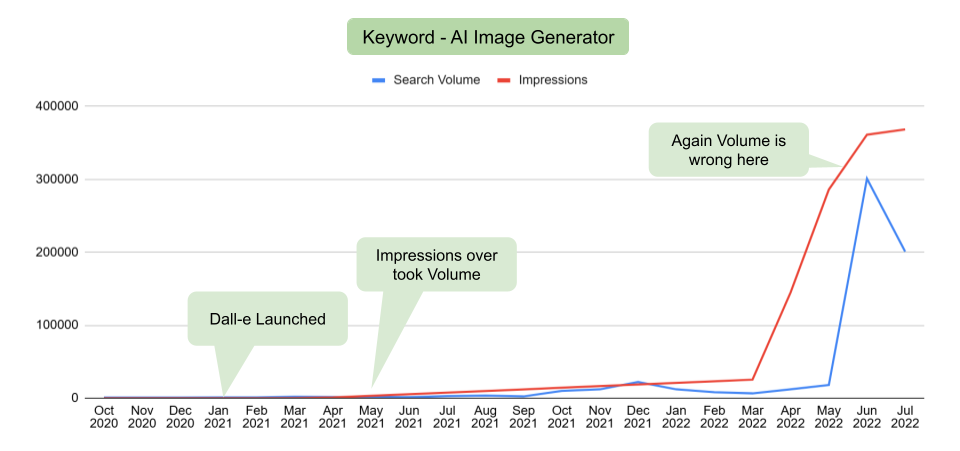
4. Non-targeted keywords in the same cluster are all Low-hanging fruit keywords
A keyword gap compared to competitors or findings from keyword research alone does not automatically qualify a keyword as low-hanging fruit.
For a non-targeted keyword to be considered low-hanging fruit, it should already be ranking for the website or have the potential intent to rank for that specific website or webpage.
When I say “potential intent”, the keyword should demonstrate a clear intent that aligns with the user’s search needs and the product or service the website or webpage provides. If any one of these is not aligned then the keyword is not what you are looking for.
How to Find Low-Hanging Fruit Keywords Using Google Search Console?
Suitable for Keywords you Rank for but not on Page 1
Step 1: Go to the Performace tab in Google Search Console and scroll down to the keyword report.
Step 2: Click on the filter button on the right side of the report to filter positions greater than 10 (as shown below)

Step 3: Filter the right keywords
Look for keywords relevant to your niche. These can be your low-hanging fruit keywords.
Carefully sort and filter keywords that match the user intent as well as the product/service you offer.
Ensure you avoid “stray keywords.” Stray keywords” are keywords that don’t align with your niche or keyword cluster.
For example, you might rank for “car under $3000” on a page focused on car insurance prices. This often occurs during the indexing and ranking phase, when Google tests different keywords for the page. Such keywords are usually dropped from the rankings quickly.
Another example would be “Allstate car insurance” but you serve only in selected states. Since the intent doesn’t fully match, this keyword may still rank for your page, but likely in very low positions.
Step 4: Decide how to use the keyword.
You can choose to use the keyword in the existing page or create a new page. The decision should be based on:
- SERP intent: Search on Google to see what pages rank for this page. If pages similar to your existing page are ranking, go for the optimization route, or else create a new page.
- If the SERP intent is mixed, where different types of pages are ranked, decide based on product/service fit.
Example: Consider the keyword green l-shape sofa with 5 seater. If you see the SERP full of results catering only to green L-shape sofas, add the keyword to your green L-shape sofa page. Whereas, you are seeing both l-shape and 5-seater results, create a 5-seater page as well.
Bonus: If you want the filtering process to be sharp consider using regex to match keyword phrases.
Informational Intent keywords (limited to question terms)
\b(?:who|what|where|when|why|how|was|did|do|is|are|aren't|won't|does|if|can|could|should|would|won't|were|weren't|shouldn't|couldn't|cannot|can't|didn't|did not|does|doesn't|wouldn't)\bCommercial Intent keywords
.*(best|free|top|vs|alternative*|review*).*Transaction Intent keywords
.*(discount|clearance|sale|coupon|voucher|buy|gift card|cheap|cost|price|purchase|order).*To match keywords with 5 words (change the number to match the word count)
(\b\w+\b\s?){5}Alternatively, this regex also works (change the number to match the word count)
However, the above regex gives more keyword data
([^” “]*\s){5,}
Use ChatGPT or Gemini to generate regex for you!
How to Find Low-Hanging Fruit Keywords Using Semrush or Ahrefs?
Suitable to identify non-targeted keywords (that you may not be ranking)
Step 1: Seed keywords into the tool
Semrush → Go to the Keyword magic tool in Semrush and seed your keyword

Ahrefs → Got to Keyword Explorer in Ahrefs and seed your keyword

Step 2: Sort & filter for relevant keywords
Both Semrush & Ahrefs allow users to sort and filter keywords based on Keyword difficulty, volumes, intent, and more.
In Semrush, you can apply filters for Keyword difficulty & intent.
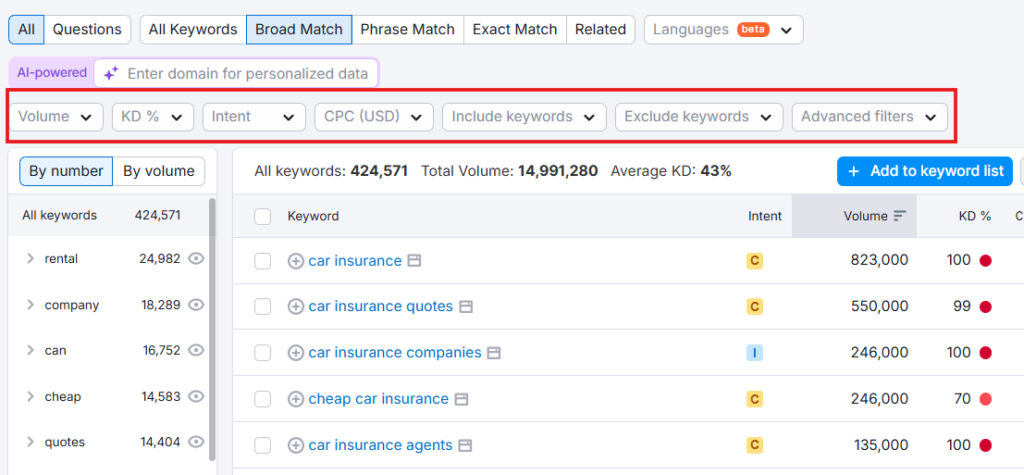
In Ahrefs, the keyword overview page has a section on different keyword ideas
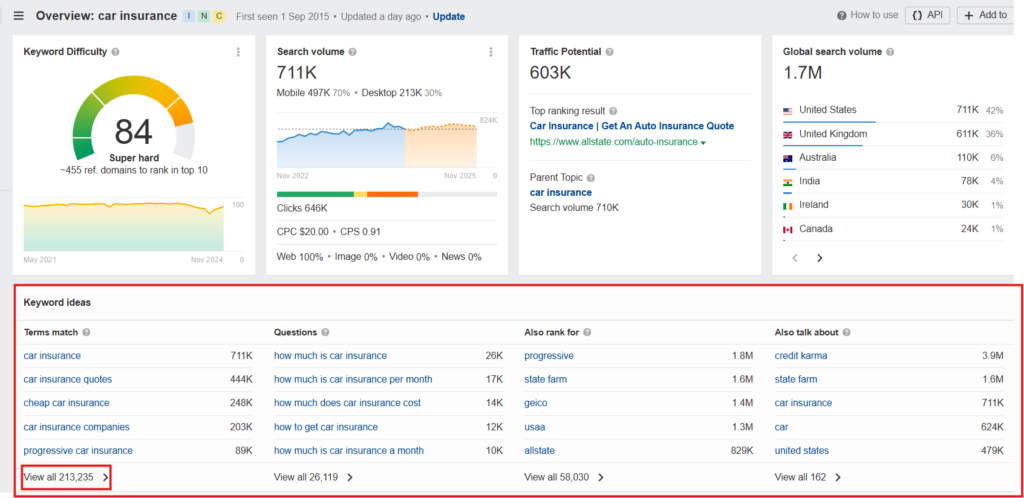
Clicking on any of these keyword ideas takes you to the list of keywords page
You can sort & filter keywords based on your requirements.
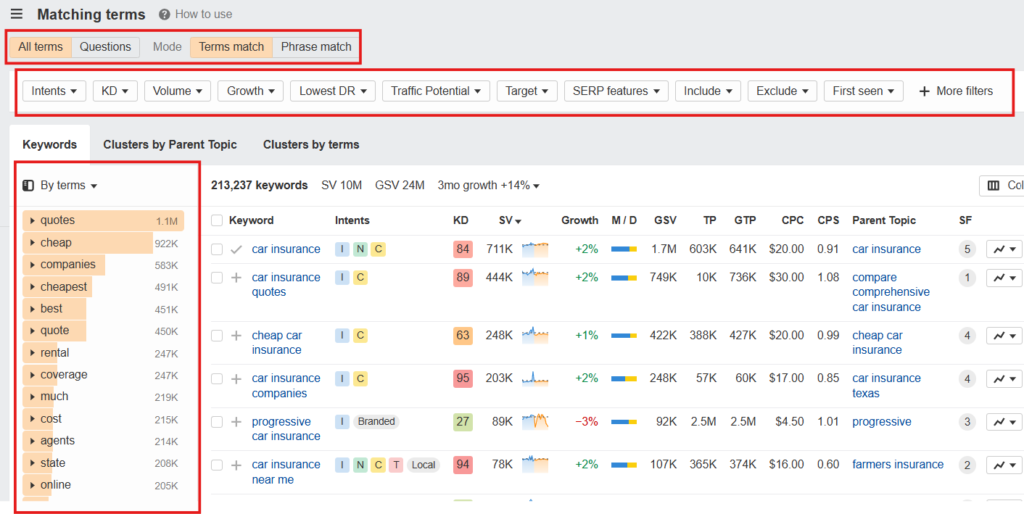
Step 3: Optimize the content based on the selected keywords
This step is similar to the one in the GSC section. Based on Search intent decide whether to optimize the existing page or create additional pages.

Consider using the Question section in these tools to identify long-tail keywords.
How to find Low hanging fruit keywords using AI Chatbots & LLMs
Step 1: Mine keywords from GSC or other keyword tools
Use AI to analyze your current rankings from GSC or Semrush/Ahrefs exports. Use the below prompt:
Here’s my list of keywords and their positions (paste dataor upload .csv file with keyword data).
Identify keywords where I’m ranking between positions 8–30 that have traffic potential.
Suggest the top 10 “low-hanging fruit” opportunities and group them by intent (informational, commercial, navigational).Step 2: Ask AI to Expand Competitor Gaps
Feed AI your competitor’s keywords (from Ahrefs or SEMrush). Use this prompt:
Here’s a competitor keyword list.
Find keywords they rank for where difficulty looks low or traffic is good, but my site does not target them.
Give me 20 long-tail variations with searcher intent explained.Step 3: Use AI for SERP Pattern Analysis
Instead of manually checking SERPs, ask ChatGPT/Perplexity to summarize patterns.
Prompt idea:
Search results for [keyword] usually include what type of content (guides, listicles, videos, tools)?
Does it look like a low-competition keyword? Suggest easier variations. Step 4: Leverage AI for Semantic Expansion
Once you’ve identified 1 seed keyword, ask AI for long-tail & related clusters.
Prompt idea:
Generate 30 low-competition, long-tail variations of the [keyword] that people might search for.
Include question keywords and “vs” keywords. Wrapping Up
Identifying and optimizing for low-hanging fruit keywords can be a powerful way to improve your search visibility with minimal effort. By focusing on keywords that are easier to rank within your existing content clusters, you can increase traffic and relevance for targeted audiences.
Remember that low-hanging fruit keyword isn’t just about low competition or volume—it’s about identifying keywords that match both user intent and the services you offer. Using tools like Google Search Console, Semrush, or Ahrefs, you can spot these keywords, filter them based on intent, and make informed decisions about optimizing existing pages or creating new ones.
With a careful approach, low-hanging fruit keywords can serve as valuable assets in your overall SEO strategy, helping you capture more traffic and engage your audience effectively.
Subscribe to Our Newsletter!

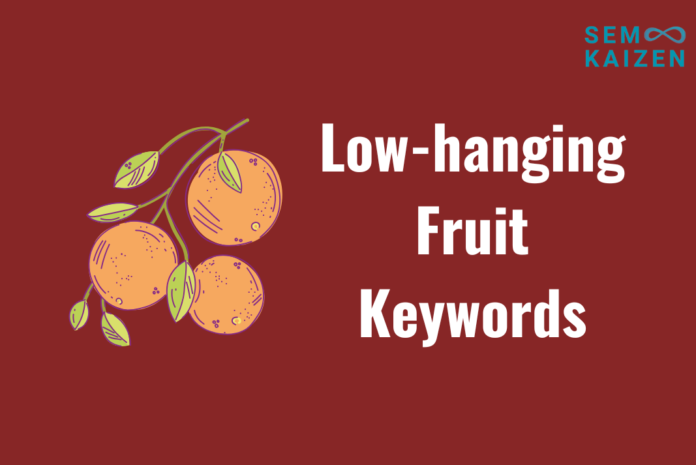
Very insightful. Are there any 3p tool to give low hanging fruit keywords other than the biggies you mentioned?
This is very clear and action packed guide.
I like your take on what constitute a low hanging fruit keyword. Thank you for this insightful guide.